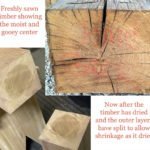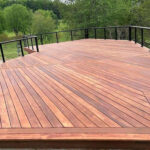 It has long been established that the only way to dry lumber is slowly with long heat up and cool down times. The maximum temperature and the rate of heating and cooling will vary from species to species. In fact, specific schedules have been published to guide kiln operators, but many kilns have their own practices which they follow, hard won through years of experience.
It has long been established that the only way to dry lumber is slowly with long heat up and cool down times. The maximum temperature and the rate of heating and cooling will vary from species to species. In fact, specific schedules have been published to guide kiln operators, but many kilns have their own practices which they follow, hard won through years of experience.
Mixing species is a common practice that has been the catalyst for some of this customization. Despite the variance you will find from kiln to kiln and from species to species, the one constant is that thicker lumber is much harder to dry completely without significantly damaging the wood. Until now. A new radio frequency (RF) vacuum kiln technology is revolutionizing how heavy timbers are being dried.
Thicker timbers take a very long time to dry and, inevitably, result in checking and unsightly cracks. The problem is that as the outer layers dry, they act almost like a shield or insulator, preventing the interior from drying at the same rate. If heating continues or if the temperature is raised, either damage will result to the outer fibers, or worse, the moist core will break and separate, creating what is known as “honeycomb” lumber.
The solution has been to dry the timbers about 2″ deep and leave the core in the 15-20% moisture range. In this instance, the outer dry fibers are usually adequate to maintain the stability of the timber. The problems arise when the lumber is planed, and the outer dry shell is reduced in thickness, thus changing the stability and possibly unevenly exposing wetter fibers. Also, every time the timber is cross cut, there is potential for checking as the moist core is exposed.
One of our suppliers has patented an RF vacuum kiln that completely changes this process, making 100% dry timbers possible without damaging the wood fibers. In fact, the lumber is in better shape and acts like a traditionally air dried product with no damage to the cell wall and is a much easier material to work.
This is a two fold process. First, the lumber is loaded into the kiln and the pressure is dropped. This lowers the boiling point of the water locked in the lumber to 90 degrees F, and thus won’t damage the outer wood fibers. The constant vacuum of air draws the water out the same way it circulated into the tree while it was alive: through the end grain. This further prevents cell wall damage.

Currently this mill is only drying Douglas Fir, Western Red Cedar, and White Oak, because these are the species in demand for large timber construction. We are bringing in Douglas Fir primarily based upon customer demand and have been really happy with the quality of the wood.
Essentially, any species could be dried this way, but it begs the question of why the industry as a whole has not adopted this technology? Certainly the kilns themselves are quite expensive, but the biggest issue is that the company that invented these kilns, Heatwave Technologies Ltd., has since gone out of business, and the startup costs to produce them again as well as the engineering costs are too steep for anyone to swallow at this point. So if any aspiring engineers are reading this and think they can jury rig a solution using Tupperware and your favorite HAM radio, give it a shot. The lumber industry would love you.
In the meantime, if you want timbers that will work for both interior and exterior applications that are truly dry and stable, drop us a line or give us a call and ask about Tru-Dry timbers.









“Radio waves in their purest form are just the vibration of air. ”
Guys, you can’t say this without coming off as total idiots. If you write stuff like this, how on earth can I trust anything I read here?
You may well have found a way to dry large lumber without buggering up the structure, but sounds like an over-sized microwave oven. If I am essentially right, why not say just that?
Sincerely
Liam
How about this instead?
My knowledge of Physics is rusty! Good thing we deal in wood products instead of running Fermi Labs eh?
I had some experience with RF kilns several years ago with a man from Salamanca New York. We had exceptional results with the wood we sent through his kilns. I have been out of the industry for several years, but now have a chance to return so the first thing was to check on RF kiln progress. I would be interested in any manufacturer information you would share.
Thanks
Raymond
Raymond the kilns are operated by Capital lumber nowadays. It was originally built HeatWave Technologies LTD but they are no defunct.
I was involved with a company named Power Dry in the early stages of using RF and vacuum drying of wood products. My speciality is RF and I know what you are talking about here. I was involved in the commissioning 13 of these kilns and the R&D. The technology viable but the cost have very high. I think if people would realize the benefits of this process they see the value.
I ran 8 of those RF/V kilns that Tom mentioned. For years, I thought RF/V was the only way to dry heavy material. For the past 25 years, I’ve used water heated vacuum kilns. They are much simpler to operate. They are extremely economical. And I have dried Douglas fir up to 18″ thick. And for products like 12/4 and 16/4 lumber, you can’t beat the quality from a water heated vacuum kiln.
We have been using RF kilns for the past 12 years to dry our super saturated water recovered timber. RF is the only way to go. Initially we used a Heat Wave kiln but now use other equipment that we have adapted for our process. If you are looking for RF drying equipment give us a call. We can set you up for less than half the cost of a Heat Wave RF kiln.